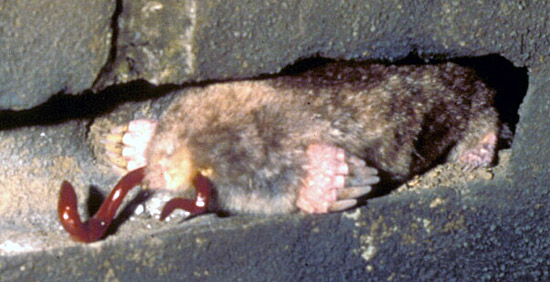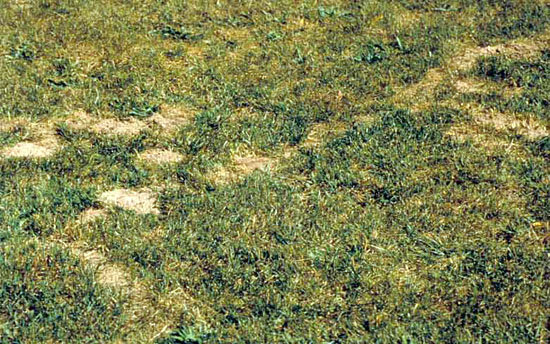Issue 16, September 14, 2009
Moles
The eastern mole, or common mole (Scalopus aquaticus), is the most numerous and has the widest range of all North American moles. Moles are covered with soft, gray to brown fur and are about seven inches long with short tails. They have naked, pointed snouts and shovel-like front feet. Moles feed primarily on earthworms, beetle grubs, ants, and various other small animals found in the soil. A smaller portion of their diet consists of various seed and vegetable matter. But they usually do not eat bulbs or the roots of trees, shrubs, or other plants.

Moles can be destructive pests in lawns, gardens, nurseries, parks, golf courses, and cemeteries. During their burrowing activities, they produce mounds and ridges that disfigure lawns and sometimes dislodge plants or injure roots. Although tunnels under trees and shrubs can injure roots and expose them to drying air, causing those roots to die, too few roots are affected to impact the health of the trees or shrubs - even in heavy infestations. Thus, moles do not warrant control except for aesthetic effects on turfgrass. Home ranges are usually one-fourth to one-half acre in size, although male moles can have ranges of over four acres.

Shallow tunnels in which elongated ridges of turf are pushed up are created during the growing season. Feeding tunnels typically wind with several curves and dead-end. The mole created this tunnel while feeding on earthworms or insects. Once the mole had eaten enough or food became scarce, it turned around in the tunnel and went back to the rest of the tunnel system. These winding, dead-end, feeding tunnels are usually not revisited by the mole.
Straight tunnels which join other tunnels are used almost daily by the mole in getting from one part of the tunnel system to another. Recent research indicates that these straight tunnels are also earthworm traps. Earthworms encountering these tunnels when burrowing through the soil tend to turn and crawl down the tunnel rather than proceeding through to the other side. The mole inspects these tunnels regularly, eating the earthworms crawling down them.
Mounds of loose soil are indicative of a deep tunnel. These cone-shaped mounds are usually four to six inches high and about one foot in diameter. They are usually present in pairs, with each mound being six to twelve feet apart. Beneath each mound is a vertical tunnel that extends five to eight inches below the surface to a horizontal tunnel. Being deeper within the soil, these tunnels do not result in a ridge on the soil surface. The horizontal tunnel runs to the vertical tunnel beneath the adjacent mound.
Deep tunnels are used by the moles for bearing and rearing young. Thus, the presence of mounds usually indicates the presence of a reproducing pair of moles. Generally, mole pairs locate in more natural areas that provide a more constant food supply than do lawns. Thus, mounds are usually found in forested areas, areas near streams and rivers, old fields, and pastures. They are commonly seen in fence rows rather than in mowed areas.
Occasionally, the soil type is not conducive to surface tunneling. Under these circumstances, feeding occurs deeper under the surface and the mounds can represent the end of one of these deeper feeding tunnels.
Moles mate in late winter, resulting in young being born 24 to 48 days later in late February to June. Litter size is typically four young. Young are born only once per year, and the young stay with their mother through the summer. Those that near maturity in late summer or early fall due to an early litter or abundant food are expelled by their mother. Others resulting from late litters or slower growth are not driven from the home range until early spring when their mother is about to bear another litter.
It is these adolescent moles striking out on their own that typically venture into lawns and other maintained turf areas. Damage to turf is normally seen in spring and again in fall based on when they are driven from their mothers' range.
Years ago, moles were driven from turf areas by applying a grub control insecticide. It was thought that if you controlled the grubs, the moles would leave. This belief has persisted through the years. However, this same technique has rarely worked in recent years. Currently recommended insecticides typically kill 90-95% of the grubs whereas those used earlier typically killed 40-60% of the grubs. However, current insecticides used for grub control are relatively odorless compared to chlorpyrifos (Dursban), diazinon, and other organophosphates used for grub control during the 1970's and 1980's. Many of the organochlorine insecticides used for grub control during the 1950's and 1960's were also odorous. With mammals possessing excellent senses of smell, it may be that the moles were driven out of turf areas by smell rather than loss of prey.
Their continued presence in areas treated with insecticides is a testimony to their ability to rely on earthworms for food. It also illustrates the relatively low mortality caused to earthworms by currently recommended grub control insecticides.
Moles are primarily controlled with harpoon or choker traps set across straight tunnels that intersect with other tunnels. The tunnel is mashed down, and the trap is set on that area. As the mole comes down the tunnel, it tries to rebuild the destroyed tunnel springing the trap, killing the mole. In heavy soils, it is useful to spring the trap once or twice to create openings where the harpoon or jaws can travel.
Bromethalin, sold as Talprid, is also available for mole control. The pesticide is sold in a plastic worm. A hole is made in the top of a straight tunnel, the "worm" is dropped into the tunnel, and the hole is repaired. This limits the exposure to pets and other non-target animals.--Phil Nixon
Author:
Phil Nixon